Explore Murals WIN $$$
Welcome to the Ashland Mural Tour!
Ashland is the “Historic Mural Capital of Wisconsin”. With 23 historic murals in the city, we literally have an outdoor museum and history book on our buildings. The majority of the murals are located in an 8-block historic district, but there are a few that are found outside this area including an indoor mural at the Northern Great Lakes Visitor Center, and outdoor mural at the Middle School Football Stadium.Each mural depicts a piece of our past from the Oredock which at one time was the largest steel dock in the world, to the Lumberjack Mural which is majestic in the size of the lumberjacks and the one extraordinary lady who was the cook, doctor, seamstress, housekeeper, the “Jill of all Trade”. Ashland is a friendly, walkable community, and the mural walk is NOT weather dependent. You can view the murals from the comfort your own vehicle, or by foot. The outdoor murals are always available to see.
The Mural Trail was created to incentivize your mural experience. Here is how it works:
– Visit 7 murals and your name will be entered into a drawing to receive $100.00 in cash.
– Check in at 12 murals and enter into a drawing for $200.00 in cash.
– Check in to 18 murals and enter in a drawing of $300.00.The Historic Downtown has all sorts of retail to offer as well as food and beverage. Spend the day in Ashland, where you’ll find yourself, Next to the Water
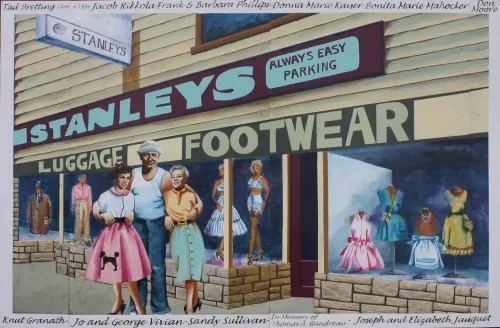
Here you can step back in time as you take a look at the 1950s Snapshot Mural located on the outside of the east wall. Artists Kelly Meredith and Sue Martinsen were approached by the building owner to paint this mural. It was completed during the summer of 2007.
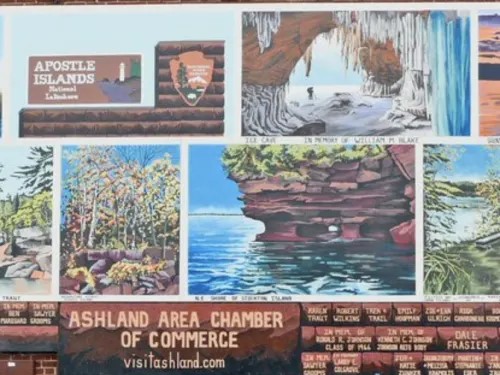
Apostle Islands National Lakeshore Mural
This mural was sponsored cooperatively by the Friends of the Apostle Islands organization and the Ashland Mural Walk Committee to celebrate the The Park Service’s 100 year history. 18 of the 22 Apostle Islands are located within Ashland County and the southern most tip of the park is located at the Ashland lighthouse in Chequamegon Bay.

The Asaph Whittlesey Mural located at the corner of U.S. Highway 2 and State Highway 13 was completed in the summer of 1998. This was Ashland’s first mural, started with an idea by Mary Rehwald, Director of Lifelong Learning at Northland College. Rehwald and a group of community people got together and applied for a grant to the Wisconsin Sesquicentennial Commission. Their efforts were rewarded with a grant for $8060.00. Additional funds were received from the Ashland Foundation, the Chequamegon Area Arts, the Rotary Club and an anonymous donor.
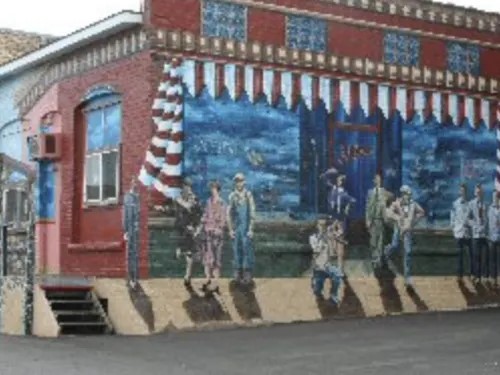
Aviation, 1920s Jazz Era, & Schiller Shoe Store Mural
The next mural was the Aviation Mural located on the lake side of the 300 block, Main Street West. This mural, completed in the summer of 1999, celebrates Ashland’s early aviation history, its jazz past, and Schiller’s Shoe Store that was once housed in the building on which it was painted. The artists came up with the idea themselves and went to the owners of the building for permission to paint the mural there. Then they went to the business community for donations.

The Bayfront Mural represents industry along the Ashland shoreline in the 19th century. Featured are old steam and sail boats at the oredock, the original Hotel Chequamegon, and a blast furnace at the Ashland Iron and Steel Co. Also, we see boats transporting lumber, as well as ships parked by the side of the coal dock. This mural was commissioned by Ralph and Sue Brzenzinski who previously owned McDonalds.

Cabbies and Stagecoach Mural
This mural tells the history of a small hole-in-the-wall 18 year old beer bar frequented by
locals and Northland College students alike from the early 1960s through its expansion into a modern 21 year old bar known as the Stagecoach Bar and Grill.
When the artist first made an appeal to the public for photos of their experiences in the bar she was met with “What! No one took photos of being in a bar in those days!”. So the
artist began collecting stories instead. The result is a hybrid of actual people and painted images that tell the stories.

Chequamegon Food Co-Op Mural
Community mosaic mural located on the west side of the Chequamegon Food Cooperative building, 700 Main Street West.
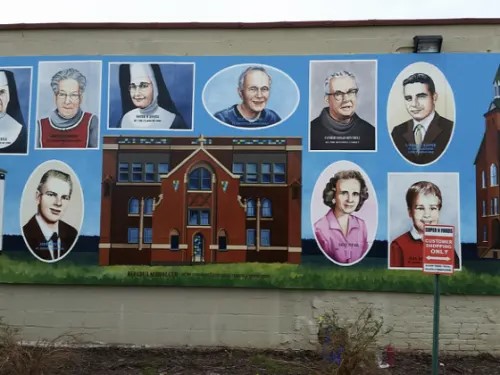
This mural features (l to r): the St. Agnes School, the DePadua School, the DePadua Gym and the Holy Family School. The portraits of individuals association with the schools are: bottom row (l to r): Donna Dormady , Sheila Urling, Father Humbert Korgie, Sister Alicita, Norman De Briyn, Sally Pufall, Alan Ryan Tomczak, Sister Joyce Miller, Anton Felix Penn, Sister Ruthmary. Top row (l to r): Fern Hunt, Janice Berweger, Rev. John Chebul, Sister Paula, Shirley Huybrecht, Sister Annita, Buzz Leciejewski, Father Conan Mitchell, Lawrence Kasper, Sister Henriella, Della Nemec, Jerry Nemec, Father Alois Gabrus, and Betty Marx Bradle.

Next stop is Dhooge’s Store Mural located 9th Ave West and Main Street. This mural was commissioned by the Chequamegon Food Co-op. After they moved into their new location the mural was moved to its current location the artists came up with the idea of a shopping day around the end of the 19th century. In this era — just after the “cutover” — the settlers began to farm the land. They would come to town occasionally for supplies, a trip that often became a two-day event.
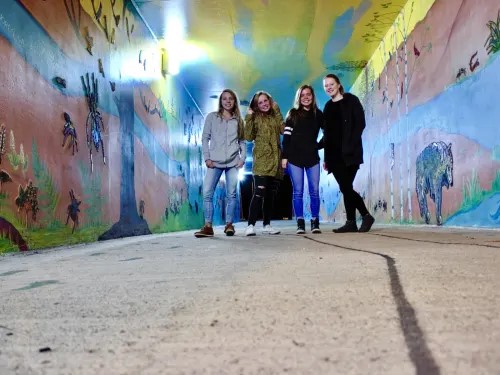
Ed Griffiths Pedestrian Pass Tunnel
A Mosaic mural located inside of the Ed Griffiths Pedestrian Pass, a tunnel under Hwy 2/Lake Shore Drive and provides a passage from Pearson Plaza to Ashland’s Waterfront Trail, a Walking/Biking Trail that circles the City of Ashland. Look for the scavenger hunt on the mural wall. The landscape mosaic/mural hybrid spans the entire length of the underpass – 3,684 square feet – and highlights the ecology of the region. A Community Project. You can access the tunnel by the 6th Ave West Beach or behind City Hall 601 Main Street West.
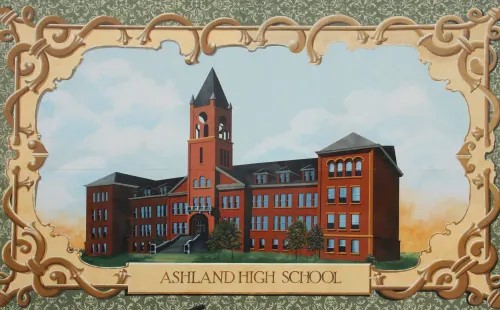
Historical Ellis Avenue Mural
This mural depicts three of Ashland’s most notable and historic brownstone buildings, all located on Ellis Avenue. Wheeler Hall is the northernmost building. Originally the North Wisconsin Academy, founders raised around $30,000 for construction of the main building. Its cornerstone was laid on July 14, 1892. Wheeler Hall originally housed classes, dorm rooms, the president’s residence and faculty housing. The whole school was housed in this building, which was named Wheeler Hall in honor of the Wheeler family’s service to the region and to the institution. This building is still standing on the campus of Northland College. Ashland High School and Knight Hotel were both designed by German born Henry Wildhagen (1856-1920). He came to Ashland to design a paper mill for the Menasha Paper Company and liked it here so he stayed. He designed the four distinctive stone and brick schools in Ashland between the years 1895 and 1905, as well as 15 schools elsewhere.
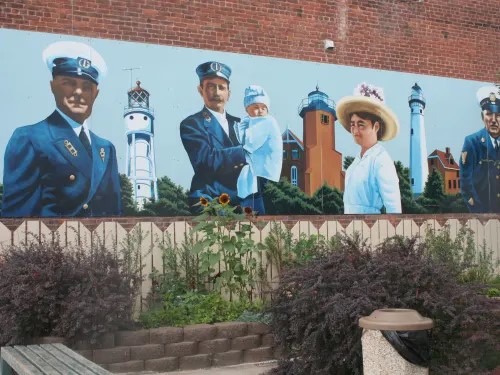
Lighthouse Mural
View Website
The Lighthouse Mural located on the corner of Chapple Avenue and Main Street was also done in the studio during the winter of 2000 on panels. The mural depicts three Apostle Island lighthouses and their “keepers.”After seeing the mural, Lois Spangle, who lives in Ashland, called the artists and told them that one of the keepers in the mural was her father, Alphonse L. Gustafson. He was keeper at the Devils Island Lighthouse from April 1945 until his death on April 29, 1951. The other people in the mural are Emanual Luick and his family from Sand Island and A.G. Carpenter from Outer Island.

The Lumberjack Mural, located on 4th Avenue West just north of Main Street, depicts some of the men (and one woman) of Ashland’s lumber era, when the workday was from 4:00 a.m. until dark. An average day’s work for a pair of “sawyers” was 100 pine logs, and they each made $1.00 a day. In 1893, 10,000 lumberjacks worked in the logging camps that supplied Ashland’s 10 sawmills. Logs were transported by horse-drawn sleds on ice roads, by river where the logs were watched over by “jam crackers,” or by tug boats that hauled great “pulp rafts” across Lake Superior from the North Shore.

Northern Great Lakes Visitor Center Mural
“The Community of Life: Our Evolving Relationship with the Land” mural is sponsored by The Friends of the Center Alliance. This mural graces the inside walls of the Northern Great Lakes Visitor Center’s tower located 2.5 miles west of Ashland on Hwy 2. It depicts the evolving relationship between humanity and the land over the course of time, starting with pre-contact Annishinabe and up to the present. It attempts to show humanity’s impact on the ecosystem-how land use affects plant and animal populations and how changes in those populations in turn affect the future. It challenges viewers to predict this future-will we live in harmony with the world around us or will we become alienated and fractured from the natural world. This mural was created and painted by Kelly Meredith.
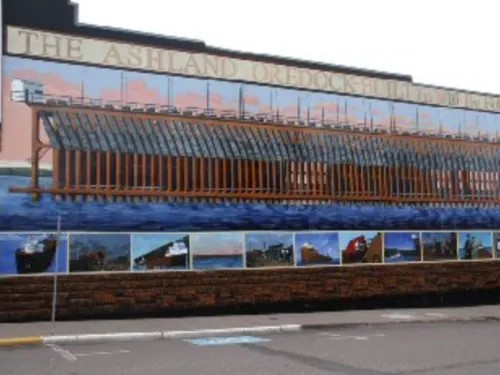
This mural depicts the Ashland Ore Dock, which was built in 1916. This monumental structure measured out at 1,800 feet. It was the largest concrete dock in the world. It is a beloved landmark to the city of Ashland residents, recalling a time past where shipping was an integral part of Ashland. The Ore Dock Mural depicts the iconic structure that defines much of Ashland’s very identity. This dock was used by the Soo Line Railroad to transport iron ore mined in upper Michigan to waiting ships in Ashland’s harbor. From there the ore was shipped south to the great steel mills of the Midwest.
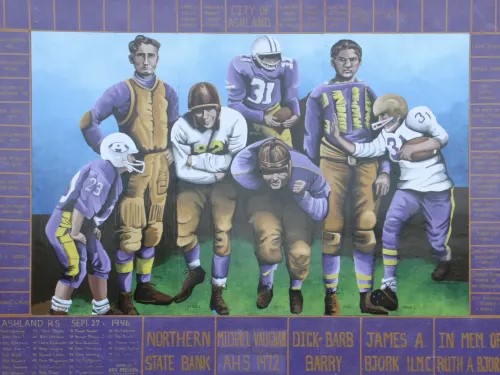
The mural pays tribute to the rich heritage of Ashland’s Football program which dates from 1896. It is located on the new entrance to Ashland’s Football field at the corner of 3rd Avenue East and 11th Street. Looking left to right the eras represented are: 1980’s, 1890’s, 1920’s, 1990’s, 1930’s, 1020’s and 1960’s. this mural was commissioned by the Oredocker Foundation and donated to the Ashland School District.

Quality Inn of Ashland – Voyageurs Mural
Stop in at the Quality Inn of Ashland located on U.S. Highway 2 west of Ashland to see the extensive interior murals representing the history of the voyageur era. There are two separate murals: one in the lobby and one in the pool area. These murals were painted in the studio.
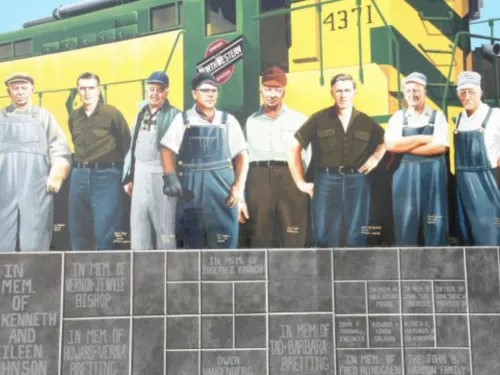
Located near the historic Soo Line Depot building, this mural represents both the Soo Line and Chicago and Northwestern rail lines that served Ashland. As with most towns, the railroad was Ashland’s life blood that made a great deal of its commercial growth possible. All of the men are actual railroad workers.

The Storefront Mural, located on 4th Avenue West just south of Main Street, was painted during the summers of 2002 and 2003. At the request of the building owner, Sue MacKenzie-Smith, the artists featured a variety of architecture found in the Ashland area. The artists did all the research themselves at the Ashland Historical Museum, where they found lots and lots of information. The buildings in the mural were not placed in the order in which they used to appear on the actual street. They were simply arranged by the artists in a pleasing array that would clearly represent Ashland’s past. Some of the buildings are still standing while others are not.

Next, The Bureau of Indian Affairs commissioned the artists to design a mural. This mural would depict the historical regalia of the 10 tribes represented by the BIA in northern Wisconsin. The mural, completed in the spring of 2004, is spread out over three separate walls in the interior of the BIA’s conference room and represents a Pow Wow. The first mural represents the beginning of a Pow Wow with the entrance of the flags and eagle staffs. The second mural represents the male dancers in their traditional clothing. The third mural shows the women and children dancers. All the Native Americans portrayed are actual dancers and members of local tribes.
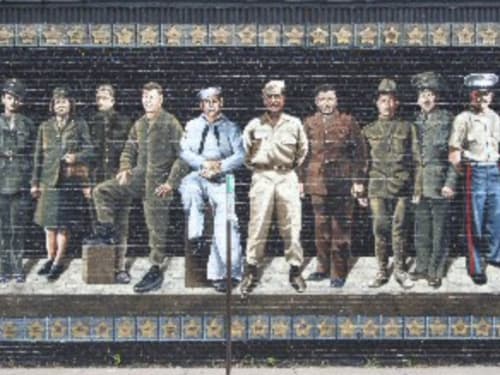
The Veterans Mural, located on the west side of the Bay Theatre Building across the avenue from the Vaughn Library, came into being after some citizens stopped on the street where the artists were working and suggested that they paint a mural celebrating the service of the Ashland area men and women in the Armed Forces. So, Meredith and Martinsen advertised for photographs in the local newspapers. Thus, all the veterans painted in the mural are actual people from the area.
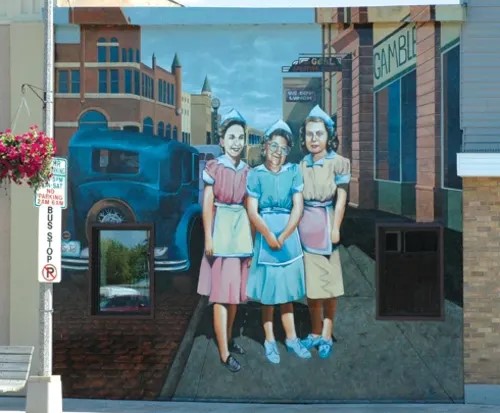
The owner of the building at 124 West Main decided to remodel. It occurred to him that, in the process, it would be a good idea to put a mural on the outside of the building. He wanted to honor Florence Dufek Larson who helped raise him and who had recently passed away. At her funeral, one of the artists saw a photo of Florence with two other women taken back in the 1940s when Florence was a waitress. The three women were standing on the corner in front of the very same building that was being remodeled. So, that photo became the basis for the mural. The waitress on the right is Florence Dufek’s sister-in-law, Delores Larson Vranes; the middle waitress is Priscilla Percy (Stelmaszewski) Muse; and, of course, then the woman on the left is Florence. At the dedication of this mural, the crowd was full of the portrayed women’s relatives.
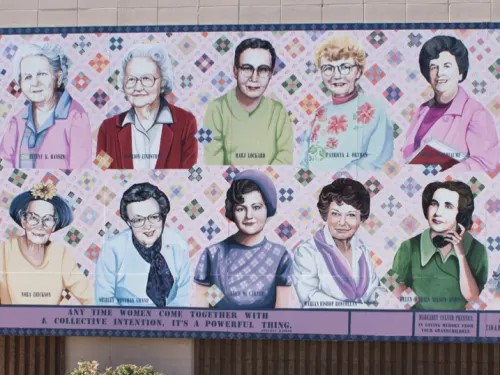
The dedication of the Women’s Mural took place on May 12, 2018
While you are here, why not check out our Waterfall & Waterways?

For more information contact Ashland Chamber Office. 715-682-2500 or info@visitashland.com
























